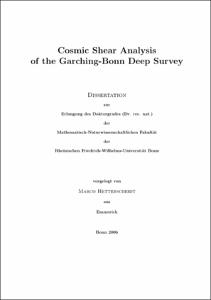Cosmic Shear Analysis of the Garching-Bonn-Deep Survey

Cosmic Shear Analysis of the Garching-Bonn-Deep Survey

| dc.contributor.advisor | Schneider, Peter | |
| dc.contributor.author | Hetterscheidt, Marco | |
| dc.date.accessioned | 2020-04-10T13:38:53Z | |
| dc.date.available | 2020-04-10T13:38:53Z | |
| dc.date.issued | 2007 | |
| dc.identifier.uri | https://hdl.handle.net/20.500.11811/3058 | |
| dc.description.abstract | We perform a cosmic shear analysis of 15 square degree high-quality R-band data of the Garching-Bonn Deep Survey (GaBoDS) obtained with the Wide-Field-Imager (WFI) at the ESO/MPG 2.2m telescope. The GaBoDS comprises 1.75 square degree of UBVRI-band observations of the Deep Public Survey (DPS). We utilise this multi-colour data set to estimate a photometric redshift distribution of a sample of lensing galaxies in the magnitude interval [21.5,24.5]. Combining the cosmic shear signal with the photometric redshift distribution we determine constraints for the total matter density and the mass power spectrum normalisation. Cosmic shear induces weak shape distortions of galaxy images and can only be measured statistically by averaging the distortion signal of a large number of galaxies. The GaBoDS is therefore a useful cosmic shear survey due to its field depth and seeing yielding the needed large number of background galaxies. Furthermore, the WFI has a very well-behaved point spread function over the total field-of-view permitting a robust PSF correction. With our automated data reduction pipeline developed to reduce such a large data volume in a homogeneous way and our robust PSF correction algorithm we are able to obtain a data set that is only mildly influenced by systematics yielding a cosmic shear signal that is not significantly biased on angular scales between 4 and 20 arcminutes. Since cosmic shear analyses are independent of any assumptions on the relation between dark and luminous matter, constraints on cosmological parameters are unbiased. Hence, we employ a likelihood analysis of our data set to estimate some of these parameters, where we use the efficient Monte Carlo Markov Chain method to estimate the posterior likelihood. As a main result we obtain for the mass power spectrum normalisation that sigma_8=0.80 +- 0.10 (1 sigma statistical error) at a fixed total matter density Omega_matter=0.30 assuming a flat Universe with negligible baryon content and marginalising over the Hubble parameter and the uncertainties in the fitted redshift distribution. | |
| dc.language.iso | eng | |
| dc.rights | In Copyright | |
| dc.rights.uri | http://rightsstatements.org/vocab/InC/1.0/ | |
| dc.subject.ddc | 520 Astronomie, Kartografie | |
| dc.title | Cosmic Shear Analysis of the Garching-Bonn-Deep Survey | |
| dc.type | Dissertation oder Habilitation | |
| dc.publisher.name | Universitäts- und Landesbibliothek Bonn | |
| dc.publisher.location | Bonn | |
| dc.rights.accessRights | openAccess | |
| dc.identifier.urn | https://nbn-resolving.org/urn:nbn:de:hbz:5N-09663 | |
| ulbbn.pubtype | Erstveröffentlichung | |
| ulbbnediss.affiliation.name | Rheinische Friedrich-Wilhelms-Universität Bonn | |
| ulbbnediss.affiliation.location | Bonn | |
| ulbbnediss.thesis.level | Dissertation | |
| ulbbnediss.dissID | 966 | |
| ulbbnediss.date.accepted | 07.02.2007 | |
| ulbbnediss.fakultaet | Mathematisch-Naturwissenschaftliche Fakultät | |
| dc.contributor.coReferee | de Boer, Klaas S. |
Dateien zu dieser Ressource
Das Dokument erscheint in:
-
E-Dissertationen (4120)




